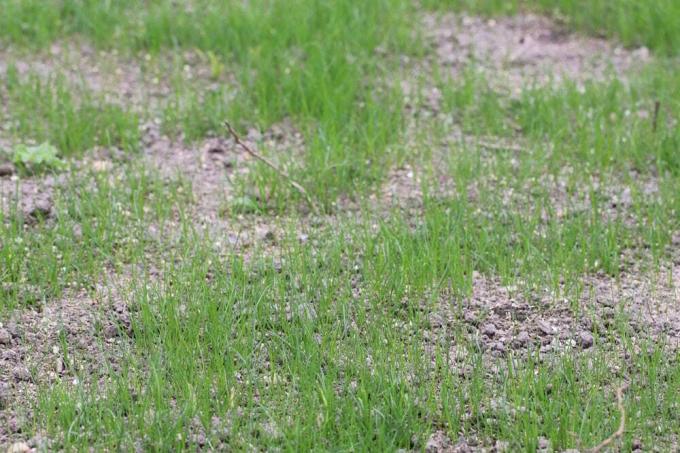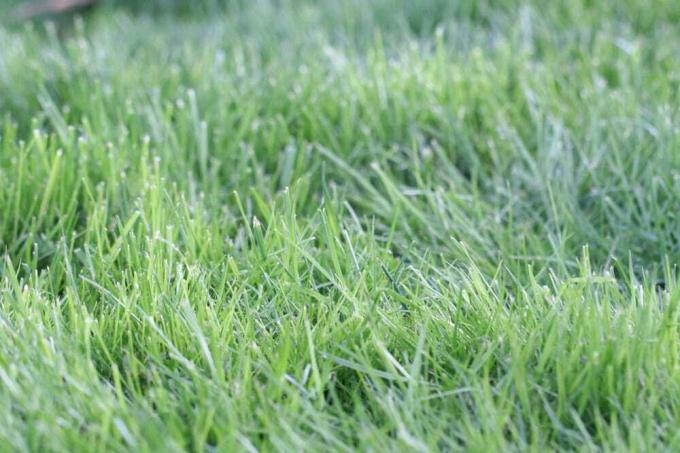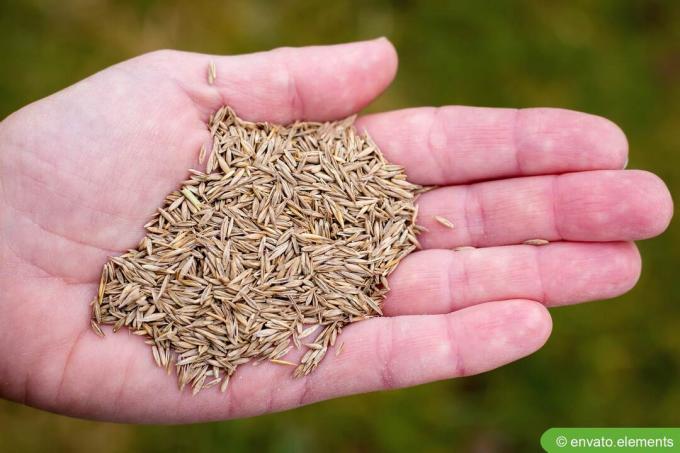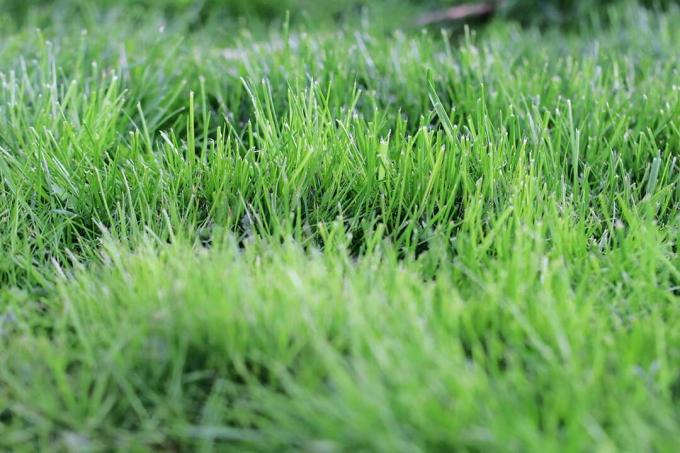

Table of contents
- Only good seeds bring good results
- Optimum germination conditions for grass plants
- The climate in autumn
- Autumn and lawn seed: fits!
- Reseeding and care: Generally unproblematic
Even if we automatically think of spring when we think of fresh green seeds, autumn is an excellent time for new planting or reseeding of lawns. Because the many small grass plants make their own demands on the conditions "happy growths" that are usually easier to fulfill in the fall than in any other Season:
Only good seeds bring good results
High-quality seed is the first point in the "process chain" that has a decisive influence on the success of your seeding project.
To ensure that there is the right mixture of grass plants in the seed pack, the research company for landscape development and landscape construction e. V already since 1978/1979 "regular seed mixtures lawn" (RSM lawn) for a wide variety of applications and Site conditions together, the use of which with professional sowing and care of the lawn has a lasting effect Guarantee greening success.
These RSM turfs are usually sold in plain bags, but differ significantly in quality from some lawn mixtures on the market, which have evocative names, but only a very short beautiful green lawn offer. In addition, with these lawn mixtures you will find exactly the lawn you need: ornamental lawn and utility lawn (for dry areas, as a lawn for playing or Herb turf), sports turf and landscape turf in a wide range of variants and many other mixtures if you have a special use on your property have in mind. There is information and the latest set of rules to buy there are the rule-seed mixtures lawn in each well-stocked seed shop.
In the case of quality seeds, the seeds of the perennial grass plants are adjusted after the harvest in such a way that they can and will germinate all year round under conditions that trigger germination; a considerable effort:
- The seeds are harvested when they are optimally ripe
- To prevent premature germination, they are dried to an optimal moisture level
- For seeds of grass plants this is 14% moisture content, standard for storable seeds
- Furthermore, minimum germination is regulated in the Seed Traffic Act (depending on the species 75 to 80%)
- The seed is stored in air-conditioned rooms, 10-15°C, humidity 30%
- The storage conditions are constantly and precisely monitored
- Before delivery, the individual batches are subjected to a germination test
This is how the seed gets to the market and from there to you, hopefully in an unchanged condition – which brings us to the next one The point is: Nowadays, a beautiful green lawn often fails simply because the lawn seed mixture was bought somewhere becomes. A package of seeds is so terribly unspectacular that it seems almost crazy to "concern the well-being of this seed" during shipping e.g. B. to make thoughts. And yet, a single seed is a veritable little "germ factory," with complicated "setup": Seed coat, embryo and nutritive tissue, all made up of many individual parts, all small to tiny and sensitive. You can recognize a good nursery, among other things, by the fact that seeds are given a place on the sales shelf where they are guaranteed never to grill in the sun or be adversely affected in any other way.

Seed from the right source is germinable for at least two and at most four years (guaranteed, often longer) after purchase. If you do not use the seed immediately after purchase, you must now store it in such a way that it remains in optimal condition. You don't need an expensive industrial warehouse, but you should make sure that the germination ability is maintained even for short-term storage does not subside until sowing (or is destroyed, which with these living mini-particles happens faster than you can thinks):
- Always store seeds in a dry place
- In a room with the lowest possible humidity
- Packed in such a way that it does not come into contact with water under any circumstances
- Even small splashes can cause the seed to swell
- More water can lead to germination, rot and mold growth
- The temperature is rather unimportant, a little frost e.g. B. no problem, only superheated steam devices/ovens should stay away
- For longer storage, plastic bags directly on the seed and thus poss. Avoid condensation
- Better to hang them up in paper or cloth bags on the ceiling of an adjoining room
- Pests that have an appetite for nutritious seeds hardly come there
Tip:
Even with the best storage, biological plant material cannot be kept indefinitely; grass seeds that have been stored too long (or that have become damp or have been exposed to the sun) should only be tried again when reseeding. If you want to close large gaps, you should mix the precarious seeds with fresh ones; large failures are too easy to see on small lawns in front of homes. Especially when sowing near the minimum temperatures, you can use up old, otherwise intact seeds very well because with the age of the seed, the demands on the germination temperature decrease (according to the motto: "Either now or never").
Optimum germination conditions for grass plants
In order for seeds to germinate once they have been sown, they must come into contact with the right soil, the right temperature and the right level of moisture.
The not particularly demanding grasses germinate in any normal to light, loose garden soil with a medium humus and nutrient content. A garden soil that deserves this name must actually exist. If you were to sow a lawn directly on a new building plot compacted by construction vehicles, many beautiful herbs that are specialists for germinating on such ruderal soils would prevail (And are also called weeds, a dense green cover does not exist). Therefore, a layer of topsoil is first applied to the construction site soil, ideally even your own Site-adapted soil removed before construction, stored at the back of the property and cared for during the construction period (should always be done according to the relevant regulations, but it often remains Theory). You don't need a very thick layer of this topsoil because most grasses are shallow-rooted and do not form main or taproots.
The right temperature for germination starts at an uncomfortable + 5° C for the grasses. At this minimum temperature, not every seed may germinate, but certainly so many that a (thin) green lawn develops. However, at 5 °C it will “eventually” develop, because the germination time depends crucially on the temperature. At minimum temperatures it just takes time, when it's warmer it goes faster, at around 16 to 23 °C meadow grasses germinate fastest. Since the + 5° C in autumn tends to be colder, when sowing at such temperatures you always run the risk that a) the seeds will freeze instead of germinating (which after mild winters but could at least bring green in spring) or worse b) the frost catches the young culms that "just crept out of the egg", which means their certain death caused.
In addition to a little warmth, the grass seed needs water to germinate or to germinate. before germination, because first of all the seed swells up through water absorption. This not only increases its volume and also creates a little space for the first one tender freshly produced root tissues, but also activates the enzymes that are important for the germination process are. Very important, the most beautiful germination fails if the seedling starves to death immediately, which is why it is given e.g. B. the enzyme diastase is added, which transforms the starch stored in the nutritive tissue into nutritious, tasty? converts sugar.

At the same time, the enzymes have broken down the germ-inhibiting reserve substances so that the seed starts germinating; if it continues to be supplied with sufficient moisture, the seed coat next ruptures to allow the radicle to grow through. In return, the cotyledons have developed in the upper part, and the leaves after them (still tiny for us Needles) are then already the first "real leaves" with which the young grass plant begins to photosynthesize operate.
The climate in autumn
The autumn climate in Germany has always been a bit friendlier than our country's northern position would suggest; cool-temperate zone, but mainly determined by the position in the transition between western European maritime climate and eastern continental climate. In the north-west, the west wind often brings sea air from the Atlantic, which has been warmed up by the warm Gulf Stream, with this "warm north-west" reaching from the coast to around the Bay of Cologne. Autumn has always been good for sowing turf in this large area: warm enough above ground, soil temperatures even more comfortable because summer warmth is still in the soil.
In the spring, the soil still needs quite a long time to warm up, when the air temperatures would already allow sowing. In addition, everyone knows late frost in spring (in the colder south-east it is traditionally only sown after the ice saints in mid-May), but hardly anyone can remember "early frost in autumn" remember.
Global warming provides even more arguments for autumn sowing: the changeable April weather has turned into warm, sunny and very dry early summer weather since the 1990s; while autumn soil is well moistened from the wet summer months (most rain falls in summer) and is kept moist by many showers plus fog.
With the increase in the mean annual temperature (1961-1990: 8.2 °C, 1981-2010: 8.9 °C), it is now also approaching the cold south-east of Germany a climate in which autumn is perfect for sowing lawns is.
Autumn and lawn seed: fits!
So one thing is certain: as long as the soil temperature is sufficient and remains sufficient during the germination period, you can still sow lawns in autumn - even in October and November.
However, if you are completely laying out a new lawn, you should check the soil temperature before sowing determine and try to estimate how this soil temperature changes during the germination period of the grasses will develop. To do this, you first need data on the germination period. The following is an overview of the average germination period of the most important types of grass in normal ornamental and utility lawn mixtures:
- Perennial ryegrass, Lolium perenne: 7 – 15 days
- Crested crest, Cynosurus cristatus: 9 – 18 days
- Timothy grass, Phleum pratense / bertolonii: 8 -17 days
- Bluegrasses, Poa ssp.: 14 – 24 days
- Red fescue, Festuca rubra: 10 -18 days
- Sheep fescue, Festuca ovina: 11 – 19 days
- Bent grasses, Agrostis ssp.: 12 – 20 days
This information is based on optimal germination conditions at 16-23 °C; if the soil temperature is lower, germination takes longer.
You can find out the current ground temperature from the German Weather Service at www.dwd.de/DE/dienstleistungen/bodentemperatur/bodentemperatur.html, a forecast of the weather for the next 14 There are days at www.proplanta.de; with both, you choose the region for which values are to be displayed.

Of course, the later you want to start, the more critical the sowing becomes: If you are at a soil temperature of 8-10 °C, you have to reckon with the fact that most of the grasses will take about a month to germinate needs. For the next 14 days you find out that no significant drop in temperature is forecast. But weather forecasts beyond 14 days are very unlikely to be realistic, and if the weather in your area is prone to "bittering", you should probably aim for around 10-20 days. Start at a floor temperature of 15 °C, with a little safety buffer, so to speak.
Tip:
In many articles on lawn sowing, it is pointed out that grass seeds are light germinators that may only be sprinkled on the surface. That's right, light is necessary, and the seedling also has a harder time when the first tender green has to make its way through large boulders (grains of earth). On the other hand, lawn seeds are delicacies for birds, and in some 'conventional' (with exotic ornamental plants), the birds are already starving in October because the “foreign green” leaves them not fed. And the light has to be there, but it doesn't exert any direct stimulus; All in all, this means that you shouldn't "bury" the seeds when sowing in October/November, but you can rake them in easily. Good soil contact even helps bring water to the seeds; so germination is more likely to be accelerated if you work the seeds a few millimeters into the soil.
With a bit of luck, water from above will come out of the clouds at this time. But you must not blindly trust the autumn weather, grass seeds must always have moisture around them during germination. If fall sends dry golden fall weather for a day too long, the seedling can die off unless you jump in with water from the garden hose. You should also pay attention to the opposite: If a freshly loosened soil is flooded by heavy rain, you may have to gutters are "punched" with a spade so that the seedlings are sufficiently supplied with oxygen.
Reseeding and care: Generally unproblematic
If you overseed right at the beginning of October, there shouldn't be any problems; rather you can count on optimal results without any further work.
In the worst case, you will have to overseed again in the spring.

When sowing in autumn, care for the seed that has just sprouted must be done with an eye on the threat of cold snaps: when the stalks are a few centimeters high, they mow the first time and then usually mow again as often as possible, with only a little being cut away each time becomes. You can do this as long as the temperatures remain reasonably friendly (around 10 °C). If it is foreseeable that it will be colder in the near future, you should let the lawn grow a few days longer, if possible, and then just before the prophesied Make the last cut of the year in frosty weather (exactly at the height of the previous cuts, for new and overseeding a height of at least 5 cm recommended).
 Home editorial office
Home editorial office
Learn more about creating a lawn

Just sprinkle lawn seed: is that enough?
At some point, every lawn will have one or two bare spots, which you can best close with quick overseeding. Read why simply sprinkling the lawn seed is often not such a good idea.

When can you mow a freshly seeded lawn?
Freshly seeded lawns require some care when caring for them. This also includes not stepping on it or mowing it at first. But timely and regular trimming of the grass is crucial for dense growth.

Straighten the garden and level the lawn: 11 tips
In order to be able to use your garden as effectively as possible, a flat surface is much better. Nevertheless, many floors and lawns are uneven, which makes gardening noticeably more difficult. With the right tips, you can straighten your lawn and soil.

Herb meadow: 6 tips for creating
A herb meadow is not only pretty to look at, but also very easy to care for. In this article, we will tell you how you can create a herb lawn!

Creating a flower lawn | 8 tips on seeds and care
If you want to create a flower lawn, you need patience and diligence. The effort is already worth it from the second year. Then the mixture of wildflowers and grasses blooms in colorful tones. Maintenance is reduced to a minimum in the years that follow.

Laying turf | Information on preparation, costs, timing and maintenance
If you don't want to wait long for your lawn to grow, rolled turf is a sensible alternative. But even with the pre-cultivated lawn rolls that can be laid like a carpet, there are a few things to consider. You can find helpful information about preparation and installation here.



